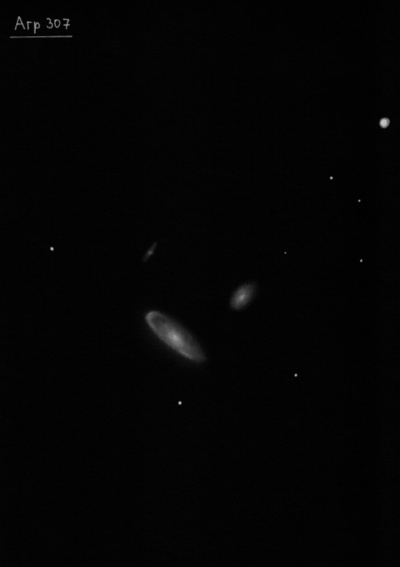
William Herschel discovered NGC 2872 = H II-57 = H II-546 = h597 on 15 Mar 1784 (sweep 172) and recorded, "Two neb. [with NGC 2874] about 3/4' or a little more from each other; Of the resolvable kind. The position of the first [NGC 2872] is about 15° or 20° np the second; they are pS and rather brighter towards the middle, but not much. The neby of the f one is rather more diluted than than of the p one, and it also somewhat larger." His position was exactly 1.0 min of RA too far west and 11' too far north. Herschel recorded the pair again two years later (H II-546 and II-547) on sweep 534, this time at the correct position, but assumed they were new. John Herschel included separate entries for the two H numbers in the GC, but Dreyer realized the equivalence and combined them in the NGC.
400/500mm - 17.5" (2/20/88): moderately bright, small, round, sharp concentration with a very bright core. Brightest of three with NGC 2874 1.3' ESE and NGC 2873 2.0' NE.
600/800mm - 24" (2/8/18): at 375x; bright, moderately large, slightly elongated, 60"x50", strong concentration with an intense core and very small brighter nucleus. Forms a striking pair with NGC 2874 1.3' S. Much fainter NGC 2873 is 2.0' NE. NGC 2871 was seen as a 16th mag star 1.1' NW.
900/1200mm - 48" (2/21/12): very bright, moderately large, irregularly round, 1.2'x1.0', sharply concentrated with an intensely bright 20" core. A mag 15.8 star = NGC 2871 is 1.1' NW. Forms a striking trio with NGC 2874 and 2873.
Notes by Steve Gottlieb